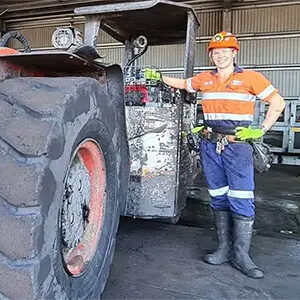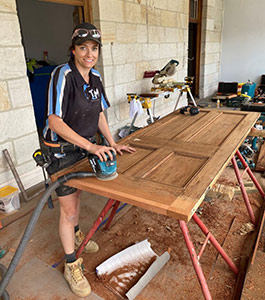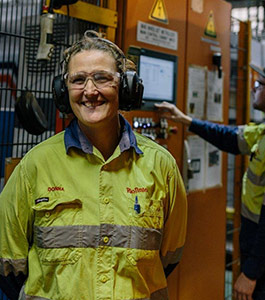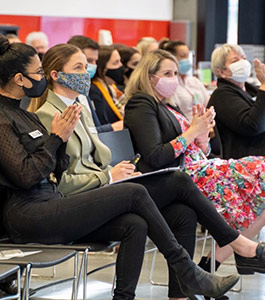
Diversity and inclusion remain vital components to allow the automotive industry to improve worker wellbeing, as well as continue to remain competitive and innovative. The Workplace Diversity Project, led by Tradeswomen Australia is supported by WorkSafe’s WorkWell Mental Health Improvement Fund. The Project, led Tradeswomen Australia, has conducted an extensive analysis on the benefits and barriers to creating true diversity within this industry, and the best way to do so. In order to test these key findings, the Workplace Diversity Project team engaged with an array of automotive industry members to find out whether the current diversity issues still remain, whether there are new issues not identified to date or issues now outdated, and develop a white paper from key findings.
The round table discussions were held on the 8,9,10 of September, and focused on three key areas: current barriers in diversity, issues in worker mental health as well as issues in workplace culture within the automotive industry. The feedback provided by participants (including experienced industry workers, industry educators, industry support groups, as well as industry service groups) are contained below.
BARRIERS IN DIVERSITY
Participant feedback in relation to diversity barriers within the automotive industry centered around:
- Lack of understanding of what diversity and inclusion really is from an organizational, education and community perspective
- Lack of understanding on how to implement true diversity within an organization, and
- Conscious and/or unconscious biases shared between the automotive industry and the community creating barriers to entering an auto workplace.
Participants commented that there was a considerable lack of understanding on what diversity is and why it is beneficial for an organization across industry workplaces, within schools as well as the general community. This lack of understanding created opportunity barriers for automotive workplaces to fix a pipeline of talented workers, as well as retaining valuable workers. In schools, career counsellors were either missing opportunities to promote auto trade careers, or steering students into university studies instead of providing students choices/opportunities in trade careers. Furthermore, the lack of promotion of auto trade careers to diverse groups, students and parents meant that the wider community remained unaware of opportunities to build an auto career. These views align with the recently published Year 13 and VERTO report, confirming a lack of awareness, lack of school support as well as parental and societal views on females entering trades were significant hurdles in commencing a trade career1.
A business’ inability to create true diversity inside and outside the organization remained a key issue to recruitment, workplace mental health and retention. Participants commented that there was still a lack of diverse role models present within workplaces, within advertising strategies, as well as lack of investment and concentrated efforts in targeting talented individuals from diverse groups. Tying into the Workplace Culture section (see below) diverse groups who could not identify with team members shown in advertisements automatically felt excluded, deciding to not to respond to the job advertisement or opportunity offered. Building and implementing proper diversity and inclusion strategies within the workplace prior to recruitment was also presented as an issue – participants confirmed that, in order to address diversity requirements, a business would simply hire an individual identifying as being part of a diverse group without ensuring that the employee had access to other individuals in the team they could identify with, or if not available a third party mentor or support member that they could connect with, as well as ensuring the team were ready and capable of accepting a diverse member in their team. In these instances, there was a high likelihood that the business would be unable to retain diverse individuals within their workplace(s). This comment aligns with Evans and Chung’s 2007 marginalisation findings, whereby businesses presented with marginalization barriers of tokenism and isolation when employing diverse individuals who did not fit into the perceived team culture2.
If businesses were already equipped with sound understanding and appreciation for diversity, they could still encounter barriers in being able to have the resources to create or improve it. Participants commented that whilst businesses understood the opportunities that diversity and inclusion could bring, they decided that they simply did not have the resources and time to cater for required changes (particularly small businesses). In identifying diversity and inclusion workplace requirements, participants noted that businesses could not cater for nor make time for:
- Ongoing, regular workshops and training for supervisors, management and staff
- Training and upskilling for supervisors
- Providing mandatory and/or required facilities for minority groups, particularly if the individual had a disability
- Proper support mechanisms and mentoring for staff
- Development of diversity and inclusion policies and procedures within their existing framework, or lack of policies and procedures overall, and/or
- Overall set up programs and time to sufficiently look after worker mental wellbeing.
From participant feedback, it is notable that employers showed different levels of commitment to diversity and inclusion, influencing their decision in committing their limited resources and time to improvement strategies. This response from participants reflects findings from Deloitte’s that auto businesses were missing out on key competitive advantages through lack of diversity support3 , as well as McKinsey and Company’s research confirming lack of leadership support in creating true diversity and limited/one off training provided to the workforce in diversity and inclusion4.
Conscious or unconscious bias was also raised as a continuing, current barrier to diversity. At a leadership level, participants commented that diversity could be rejected at the onset because of closely-held assumptions relating to diversity as a subject, diverse groups or resource requirements to facilitate diversity and diverse groups/individuals:
Making room for diversity is placed in the too hard basket for some auto workplaces – Anon.
Worker biases was also highlighted as a barrier – accumulated negative behavioural issues can tarnish not only businesses, but brands and the entire industry. Talented individuals looking for viable trade careers could be deterred from working within a particular trade if faced with the potential of being harassed, abused, bullied, excluded and other negative behaviours. Another barrier highlighted in the sessions was stereotyping and stigmas The biases of existing individual workers or worker groups in relation to accepting diverse individuals could lead to incidences of harassment, abuse, bullying, racism, everyday sexism and non-inclusion. In addition, the aforementioned biases coupled with pre-existing biases in some workplaces could also lead to recruitment, retention, legal, financial and reputational issues for a business. Participants confirmed a harmful reputational bias has been formed – the auto industry has been stereotyped as a “boys club”, all auto businesses were painted as having toxic cultures towards diversity groups, and the stigma of the trade being occupied by uneducated individuals deterring diverse, talented individuals from entering the industry. This agrees with key findings outlined by Women in Automotive and Deloitte, whereby women perceived the “working environment as blokey (and)…perceived calibre of people working in the industry”3,5. Moreover, the reputational issues noted by participants aligned with Women in Automotive’s finding that conscious and unconscious bias remained an issue in female recruitment (perceived capabilities, requirement of special treatment, pregnancy and childcare responsibilities)5, widening the barrier for gender diversity and inclusion within the auto industry.
ISSUES IN MENTAL HEALTH WITHIN THE AUTO INDUSTRY
Participants reported alarming statistics of high suicide rates within the industry, whereby toxic cultures, negative attitudes, stigma and lack of support networks were contributing factors. Apprentice and group training organisations commented that apprentices required a high amount of support mechanisms in entering and participating within the industry, which were lacking in some businesses. Industry groups noted that once workers completed their apprenticeship, there was a distinct lack of supports and networks made available either inside or outside the organization. Overall, participants agreed that stigmas and attitudes within some organisations needed to be addressed as a priority in order to protect the mental health and wellbeing of workers – namely, the stigmas concerning having mental health issues, as well as the negative attitudes encountered when speaking out about them and seeking support.
The auto industry still has the “take a spoonful of cement” and “suck it up” attitude – Anon.
Participants commented the industry’s prevailing negative attitudes towards mental health deterred individuals from approaching supervisors, managers or even co-workers about mental health issues. Considering key figures presented by AIHW, whereby 45% of Australians will encounter mental health issues sometime in their life (whether it be depression, anxiety and/or substance abuse)6 coupled with Safe Work Australia’s reporting 91% of Australia’s mental health compensation was attributed to mental stress brought about by work pressures, harassment and/or bullying, as well as exposure to occupational violence7, there is a high likelihood that automotive workers are dealing with some form of mental illness, particularly those in minority groups. Comments relating to stigma surrounding mental illnesses agree with the Mental Health Council of Australia’s findings – discussing a mental health issue is still taboo in the workplace, whereby 69% of people were uncomfortable in disclosing a mental illness to their employer, and 35% would never disclose a mental health issue8. Therefore there is a high likelihood that automotive workers are dealing with some form of mental illness (particularly in minority groups), whereby stigmas surrounding mental illness would deter individuals from revealing an issue and seeking support.
Another item highlighted of concern was the business’ leaders inability to address and manage mental health issues. Firstly, participants noted that the frontline supervisors or managers were key to improving mental health as they were the first point of contact in addressing issues within the workplace, as well as reporting mental health issues by their workers. The issue lay in their lack of training, abilities and/or experience in being able to pick up on issues and/or at-risk workers, approaching them, supporting them and having the skills to deal with workplace issues. A business may simply not invest in these areas, focus too much on the technical expertise of their leaders instead of equipping them with soft skills in team management, and continuing to invest in these crucial areas. Some businesses, managers and/or supervisors may choose to either not invest in making the time to communicate and check in with their teams, or practice avoidance so that they don’t have to deal with workplace issues. Participants commented that this created a workplace environment where workers did not feel they could approach their team leaders, be listened to and/or be provided with adequate support and resolution, they decided to leave the workplace.
From a worker’s perspective, employees and apprenticeship groups confirmed that there was not only a lack in adequate support mechanisms to assist with worker mental health, but that the workplace itself could severely affect the mental health of their workers. It was reported that some workers had a sense of dread every day in having to go to work, where they would have to deal with persistent issues of non-acceptance, negative attitudes, negative treatment, bullying, harassment, social exclusion and other areas impacting mental health. The issues were extensive for individuals identified as being in a minority diversity group – some individuals reported that they felt they had no one to go to because no-one would understand them and their circumstances, they felt isolated, excluded, their work and actions were under close scrutiny, and that they did not feel they could raise issues without receiving further negative treatment. Other issues for workers were raised by participants, including workers who simply walked away from a workplace instead of attempting to have the conversation with their team leader because they were simply not equipped with the skills to have a confronting conversation, or that individuals within businesses who had unaddressed mental health issues inflicted negative behaviour on other individuals within the organization. One participant noted younger workers and minorities tended to “cop it” because they were seen as being less powerful than the perpetrator – creating multiple issues of poor mental health within the workplace. Participant feedback aligned with key themes of overt and covert marginalization outlined in the University of Sydney’s Business School findings in female experiences in the auto industry, namely isolation and exclusion from managers and/or peers based on gender, and having to leave their job(s) because they felt it was no longer safe or tenable to continue9.
WORKPLACE CULTURE
Participants agreed that the culture of the workplace was intrinsic to the happiness and wellbeing of workers overall, particularly to people who identified as being a minority/diverse group. However, issues in toxic behaviour, negative attitudes from leaders as well as inadequate support mechanisms to create improved culture were barriers within the auto industry.
Toxic behaviours identified by participants included bullying, practices consciously implemented to devalue or stifle career progression, disrespectful behaviour as well as the normalization, acceptance and practice of bad behaviour in the workplace. Comments from participants revealed bullying practices from either or both leaders and workers that targeted minorities/diverse individuals, particularly in giving them demeaning, menial tasks well below their skills and abilities. Participants also commented that minority groups/individuals were losing out on opportunities to advance their skills, abilities, knowledge and therefore their auto careers simply because of their perceived “differences”. Some workplaces were reported to have deeply ingrained negative cultures through accepting, practicing and normalizing harassment through repeated mocking, teasing, verbal and even physical abuse, as well as previously mentioned issues of sexism, sexual harassment, racism and others.
Giving someone a hard time has been completely normalized within the industry – Anon.
In some instances, where workers asked for action and resolution, supervisors and/or managers would “laugh at them” for raising the issue. Attitudinal measures presented by the University of Sydney Business School team agree with gender based behavioural issues, whereby 24% of automotive tradeswomen have experienced sexual harassment and 43% have been subjected to offensive language or behaviour because of their gender9. In addition, the report outlined reoccurring themes of being overlooked for job opportunities, missing out on work that favoured male colleagues, and suffering significant career stasis due to gender9.
Negative attitudes also affected the ability to create real diversity and inclusion within some auto workplaces. Participants agreed that it was crucial for leaders to embrace and implement culture change from the top down, however, barriers in lack of support from the hierarchy for improved culture, or for individual workplace managers not following or enforcing policies and procedures on diversity and inclusion was a common barrier. As previously mentioned, participants confirmed that the lack of training, guidance and resources available to supervisors meant that they had no understanding or ability to effectively identify and manage conflict, biases, bullying and other toxic behaviours. In some instances where workers raised concerns, participants confirmed their concerns were not only dismissed, but they were penalized for raising them. Managerial attitudes of “one size fits all” for workplace arrangements was also raised as a barrier – parternal and maternal leave, equal pay, flexible workplace conditions and hours, provision of adequate facilities and resources were not being addressed nor considered perhaps because of the male dominated environment of the industry. University of Sydney’s Business School key findings agree with the lack of flexibility offered to auto tradeswomen, whereby only one in five females can take up part time work if they wish without it affecting their career opportunities9. Delotte’s insights reported that women were deterred from the industry due to lack of flexibility 59% and lack of flexible schedule (46%)3.
Lack of adequate support mechanisms for workers was also raised as a widespread barrier within the auto industry. As previously mentioned, some workplaces are either not providing sufficient time and investment in supports, or don’t have sufficient resources to do so. Participants reported that some businesses implemented diversity and inclusion within their workplaces, but provided little or no support for existing workers who were ill-equipped to deal with the changes. Other barriers or issues included little to no existence of proper procedures and mechanisms for workers to follow or tap into as part of workplace culture improvement (training, mentoring, programs, access to resources or outside supports). One participant reported that even large organisations encountered barriers in creating real diversity and inclusion improvements because there was a distinct lack of face to face sessions with workplaces, or that minimal sessions were conducted instead of a regular, long term sessions devoted to culture change. In addition, some workplaces hired an individual identified as belonging to a diverse/minority group, believing that they had fulfilled their diversity and inclusion requirements instead of providing adequate supports, peers, mentors or networks for the individual to tap into, along with adequate facilities for their gender, cultural or religious requirements. In relation to recruiting diverse workers, one participant confirmed that current advertisements did not sufficiently include diverse groups, and if a prospective worker could not see someone within that advertisement that reflected their diverse group, they would immediately feel excluded and not approach the employer for work.
Tradeswomen Australia Foundation wish to extend their deep appreciation for each organization, auto group and individual who participated in these forums. Their key insights and comments as to the current issues in diversity, inclusion, mental health and wellbeing within the auto industry will form how our Workplace Diversity Project team will formulate key education, training and resources for each participant in our 2021 workshops.
If you want to find out more about the Workplace Diversity Project, click here. Or if you feel your workplace would benefit from our support and assistance in creating or improving diverse, inclusive and mentally healthy environments, click here.
- Year 13 and VERTO, Females in Trades and Apprenticeships NSW Survey, July 2020, accessed via https://www.verto.org.au/images/VERTO_YEAR13_-_Females_in_Trades_Apprenticeships_NSW.pdf, accessed September 2020.
- Evans and Chun, “Coping with Behavioural and Organisational Barriers to Diversity in the Workplace”, CUPA-HR Journal, Vol. 58, No. 1.
- Lytle, R. Wagner Skarbek, R. Robinson, Shifting Diversity into high gear, Deloitte’s, 30 May 2019
- Hunt, Layton, Prince, “Diversity Matters” report, McKinsey and Company, February 2 2015
- Women in Automotive, How to attract, recruit and retain women in the Australian automotive industry, VACC, 2019.
- Australian Institute of Health and Welfare, Australia’s Health 2014, AIHW, Canberra, 2014.
- Safe Work Australia, Mental Health: work related stress, https://www.safeworkaustralia.gov.au/topic/mental-health accessed October 2020
- AccessEAP, Men’s Health – reducing stigma in the Workplace, Access EAP Newsletter, 26 September 2019.
- Oxenbridge, R. Cooper and M. Baird, One of the boys? The work and career experiences of Australian women working in automotive trade occupations, Sydney, University of Sydney Business School, April 2019.





